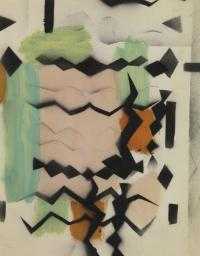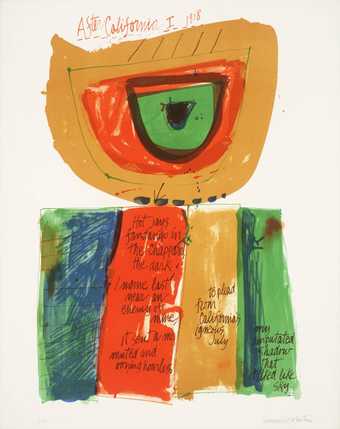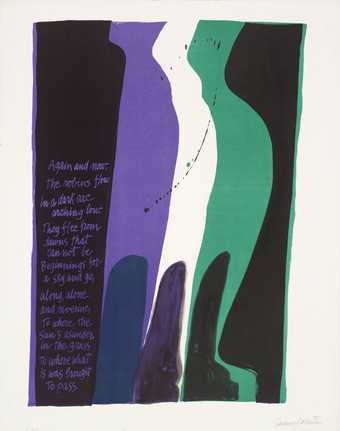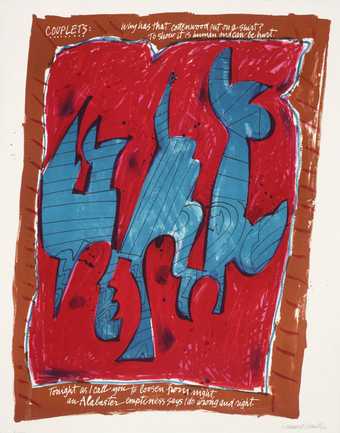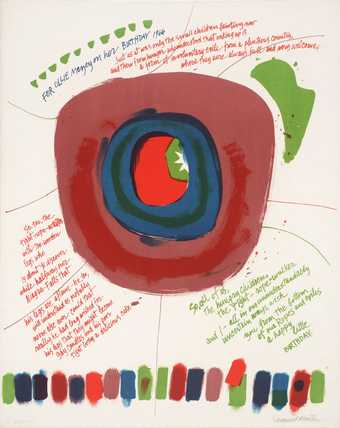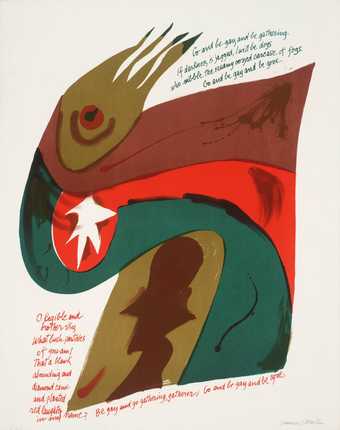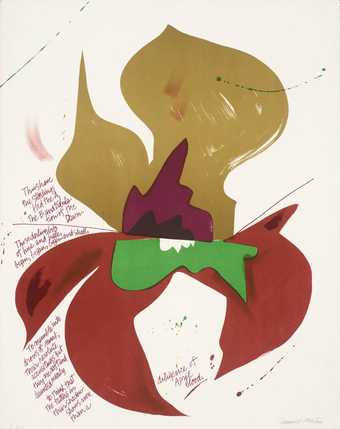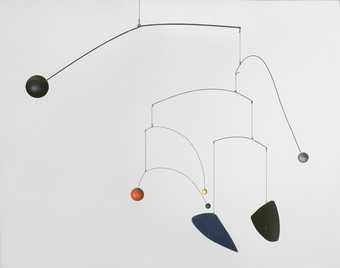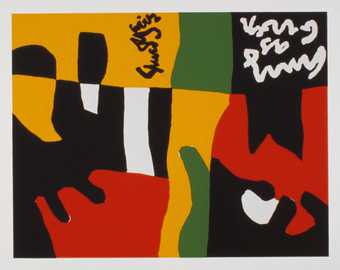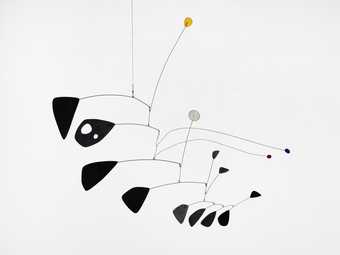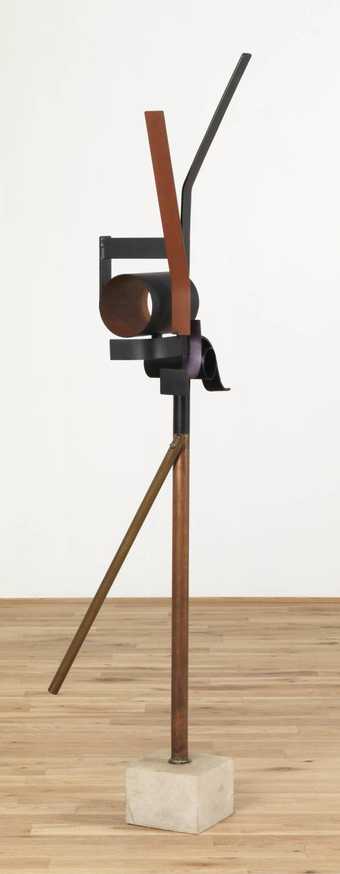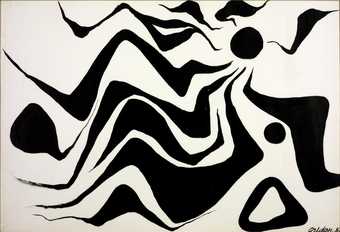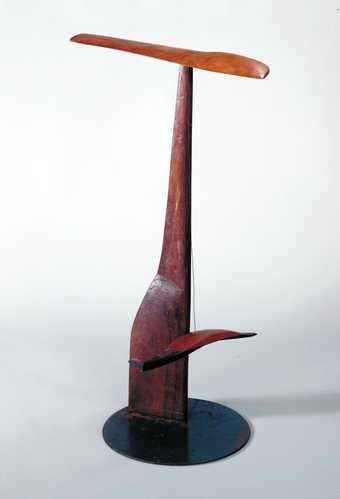
Not on display
- Artist
- Alexander Calder 1898–1976
- Medium
- Steel
- Dimensions
- Object: 2280 × 2030 × 2600 mm
- Collection
- Tate
- Acquisition
- Accepted by HM Government in lieu of tax and allocated to Tate 2002
- Reference
- T07920
Summary
As the title suggests, Standing Mobile uses a stable structure to support its extended mobile arms. The trio of angled legs are welded to the inside of the cone, from within the point of which the main curving upright springs. The upright is forged from the same grade of rod as the legs, but beaten-out to become finer as it rises and curves. One arm is suspended from this upright by a looped ‘S’ of metal, typical of Calder’s elegant forms. The red disc at the end of this first arm provides the counter-weight for the second arm, which balances organic green and yellow forms. With an elegance born out of the necessity to establish these balances, Calder used progressively thinner grades of rod for the legs and arms. The tripod stand also does away with the necessity to suspend a large and relatively heavy work from the ceiling, which had generally been his solution up to this period.
Although coming from a family of Pennsylvania sculptors, Alexander Calder turned to sculpture only in the late 1920s. He soon became absorbed by the new aesthetics and technical experimentation of modernism. His first success was the whimsical Circus, 1926-31 (Whitney Museum of American Art, New York) in which he manipulated wire figures in an elaborate performance. Still working on Circus, he moved to Paris in 1928, visiting the studios of Piet Mondrian (1874-1944) and Joan Miró (1893-1983), whose work – in very different ways – influenced his own shift into abstraction. Movement was always a key element. Calder developed hand-cranked works before embarking, in 1932, upon the series of hanging works that were dubbed mobiles (reputedly by Marcel Duchamp). The variety and subtlety of his mobiles, with painted organic forms suspended from tiers of linked rods, served to define and dominate the form.
Although primarily living in the United States again in 1934-7, Calder was associated with the burgeoning interest in abstract art in France and Britain in these years. Through his Parisian contacts he contributed sculptures, including the construction T and Swallow, 1936 (Tate T01142), to Nicolette Gray’s pioneering exhibition Abstract and Concrete in London in 1936. It appeared alongside works by Mondrian, Hélion, Nicholson, Hepworth and others. In the following year, examples of Calder’s most delicate wire mobiles with suspended spheres were included in critical anthology Circle: International Survey of Constructive Art edited by Nicholson, Naum Gabo and the architect Leslie Martin. At the same time Calder also became friendly with John Piper and Myfanwy Evans, and his work appeared in the latter’s periodical Axis.
In October 1937 Calder travelled to London to work towards a solo show opening at the Mayor Gallery on 1 December 1937. Temporarily securing a studio, he made Standing Mobile as part of these preparations. The red, green and yellow elements playfully imply the reductive aesthetic of abstraction but without submitting to the rigour of Mondrian’s primary colours. The size and weight of the structure ensure that its movement is graceful and stately, though the use of the tripod and upright means that the arms cannot complete a full rotation. It was, presumably, a desire to work on a larger scale that encouraged Calder to experiment with the tripod even if the freedom of movement was compromised. When the exhibition closed and he was preparing to return to America in January 1938, Calder left Standing Mobile with the Pipers. It remained with them as a testament to their friendship.
Further reading:
Joan M. Marter, Alexander Calder, Cambridge 1991.
Alexander Calder, exhibition catalogue, Musée d’Art moderne de la Ville de Paris 1996.
Alexander Calder: Gravity and Grace, exhibition catalogue, Guggenheim Museum, Bilbao 2003.
Matthew Gale
March 2004
Does this text contain inaccurate information or language that you feel we should improve or change? We would like to hear from you.
Display caption
Gallery label, September 2004
Does this text contain inaccurate information or language that you feel we should improve or change? We would like to hear from you.
Explore
- abstraction(8,615)
-
- non-representational(6,161)
-
- colour(2,481)
- irregular forms(2,007)
You might like
-
Andy Warhol Abstract Stencilled Images
1958 -
Sam Maitin After California
1968 -
Sam Maitin Again and Now
1968 -
Sam Maitin Couplets
1968 -
Sam Maitin For Ollie
1968 -
Sam Maitin Go and be Gay
1968 -
Sam Maitin I Have Found It
1968 -
Sam Maitin Thus Have the Starlings
1968 -
Alexander Calder Mobile
c.1932 -
After Stuart Davis Composition
1964 -
Alexander Calder Antennae with Red and Blue Dots
c.1953 -
Joseph Konzal Cretan Queen
1963–4 -
Alexander Calder Black Sun
1953 -
Alexander Calder T and Swallow
c.1936 -
Judith Rothschild Untitled Composition
1945

